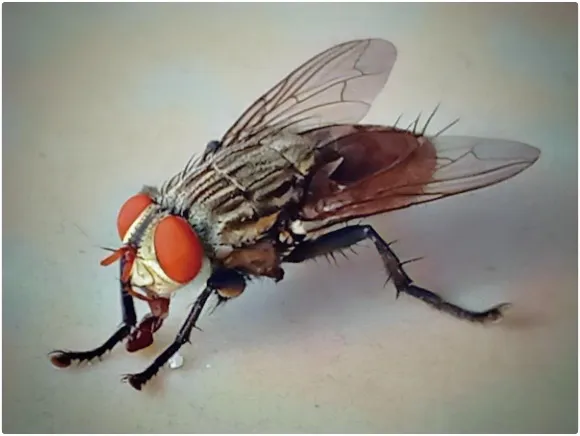As far as we know the fly is about 7 mm in size while the wingspan is 6 mm, the fly you see in this post has a size of about 8.5 mm while the wings are about 8 mm


So far, I've only seen a fly that has a size beyond the usual character. He is one of the fly species that often play and live around the house, although he is also often seen in every dirty area but he often visits every leftover someone's food.
Although it has physical characteristics such as meat flies or in scientific language this flesh fly, referred to as the Genus Sarcophaga, is often found in a person's home area. Its presence on each side of the field or yard in the community is based on the state of the environment itself. Of course, there are several animal carcasses around the environment or compost from animal waste, so that becomes a reason for their existence.
Everyone knows that flies are one of the species of nuisance insects, carriers of disease, and also some bad labels for every human life, of course, from a health perspective.

In general, this meat fly is gray-brown in color, with a characteristic stripe on its back, it looks colorless, only its big red eyes, while its general size is about 5 or 6 mm, while the line above its back is a longitudinal stripe pattern, generally has 3 stripes, extends from head to tail.
Sometimes some species have 3 dark stripes on the back and belly have a distinctive chessboard-like pattern, these dark colors are called colorless or almost black and white.

It has a very dirty behavior that is, breeds in animal carcasses, compost manure, rotting vegetables. When the mother is in the object mentioned above, she will lay her eggs in the location of the garbage object, then the eggs will hatch quickly to produce tiny larvae in a disgusting shape.
In a short time the larvae will turn into small flies that will become flies as a connector for the life span of the fly, then automatically or in a short time will also turn into adult flies in general.

These meat flies will also continue to do the same as their own mother. However it has a short life, generally having a life cycle of about 3 to 4 days, then it is either lost or dead.
Uniquely, although he have a large population, when they die the carcasses are not seen en masse or very rarely see their lifeless bodies, although sometimes they are seen but in a small capacity.

Here I see the process of death or the rest of the carcass does not look like other animals, almost has a character like some other animals, for example like cats, wild cats are very often seen living and breeding in large numbers in our area but no carcasses are seen when each of the they died.
Flies also have a large population size, but when they enter the end of their life, there are no visible corpses lying en masse in one area.
When they were born from changes in the form of larvae, of course they had a lot of them with the same day and time, while their life cycle was about 2-4 days, so on the 4th day the carcasses were not found.
The question is, where is the large number of bodies, when they turn into carcasses?
So, in this case, will be answered in a future post.....

| Photo and Text Captions | ✎ & 📸 |
|---|---|
| 🅿🅾🆂🆃 🆃🅸🆃🅻🅴 | Question for a fly |
| 💥 𝕃𝕠caţเØnˢ 𝓅H𝐨𝓣o⌖ | Indonesia |
| 𝗪𝗿𝗶𝘁𝗶𝗻𝗴 𝗗𝗲𝘀𝗰𝗿𝗶𝗽𝘁𝗶𝗼𝗻 | 𝕆𝕨𝕟 𝕨𝕣𝕚𝕥𝕚𝕟𝕘 |
